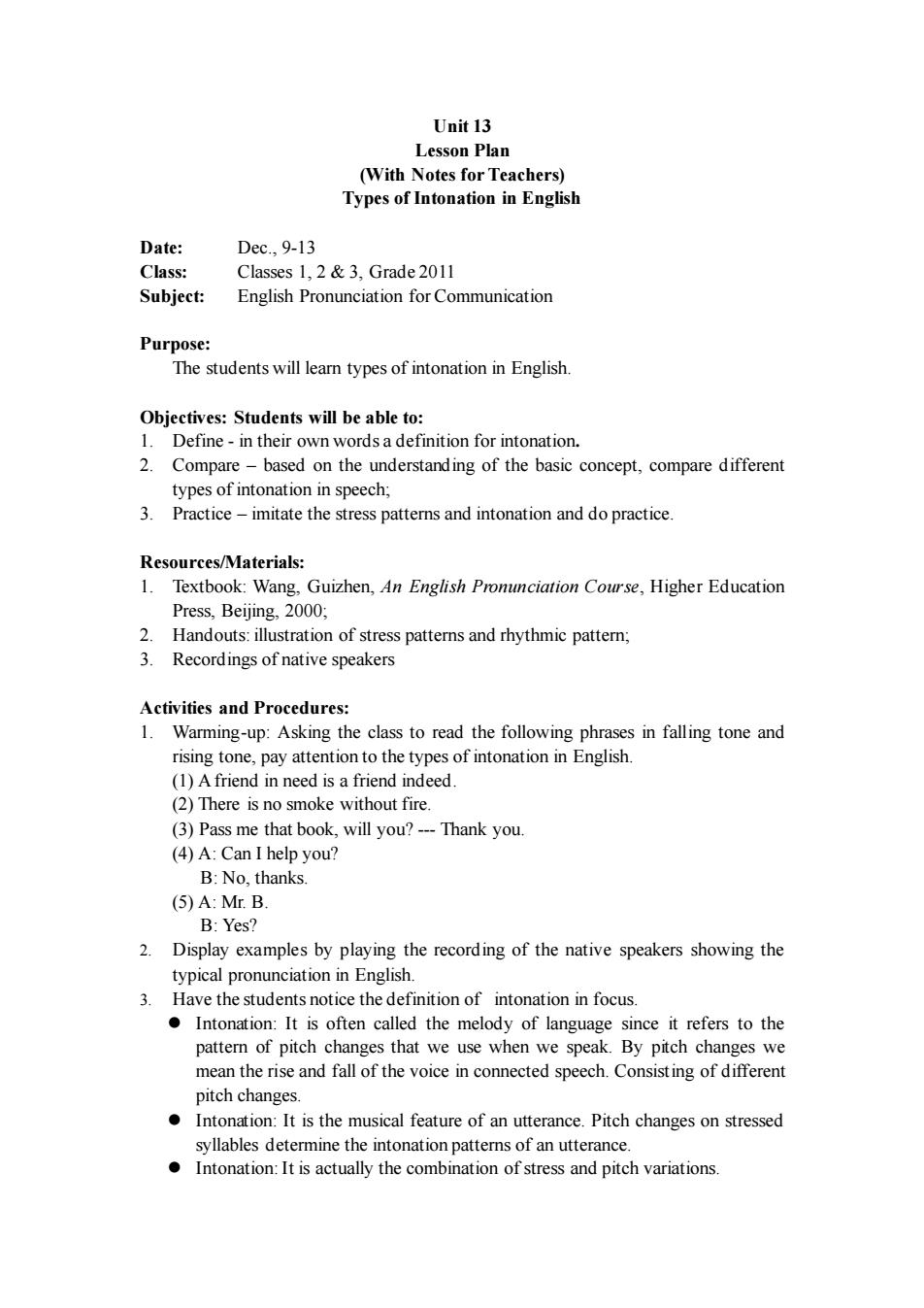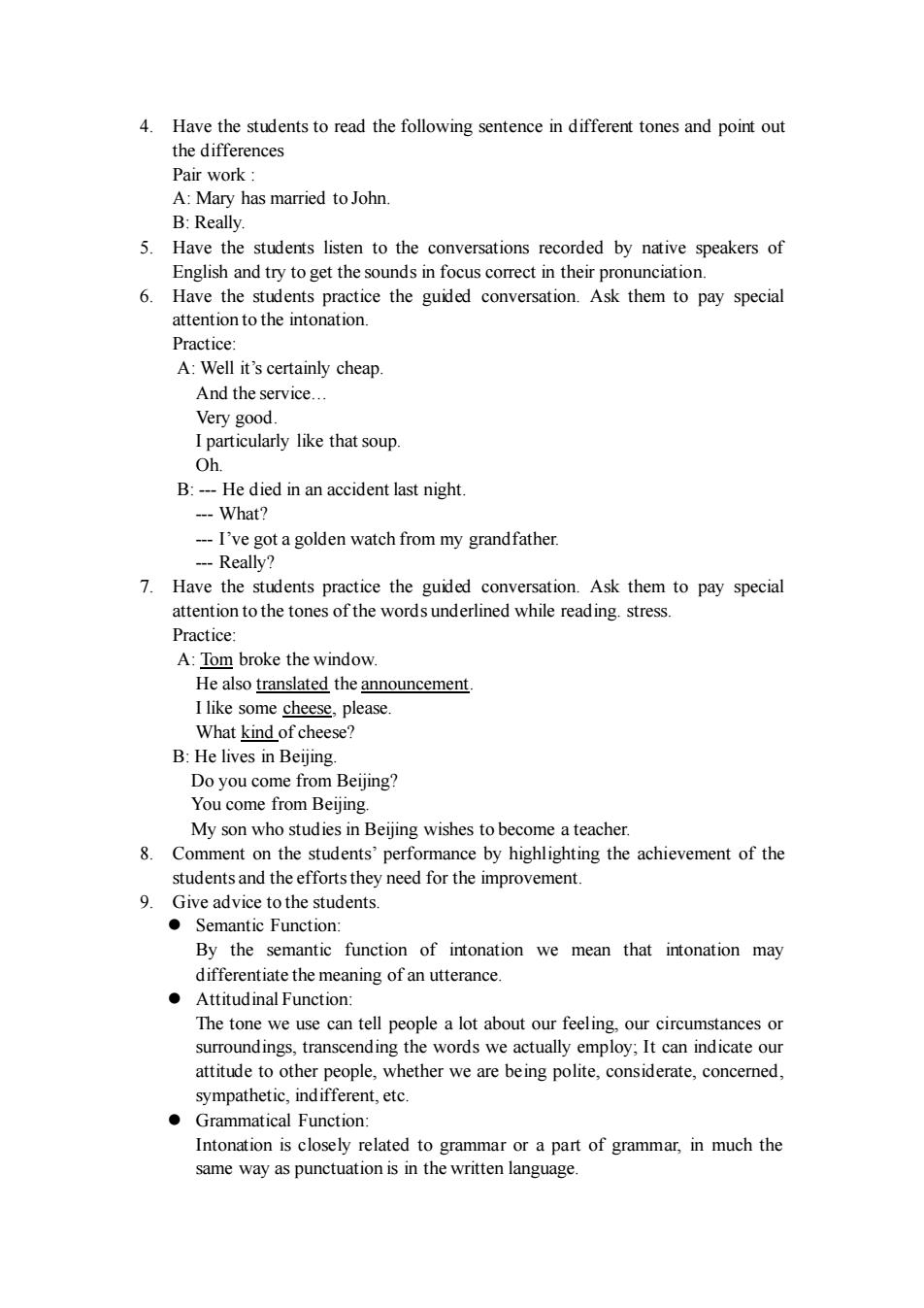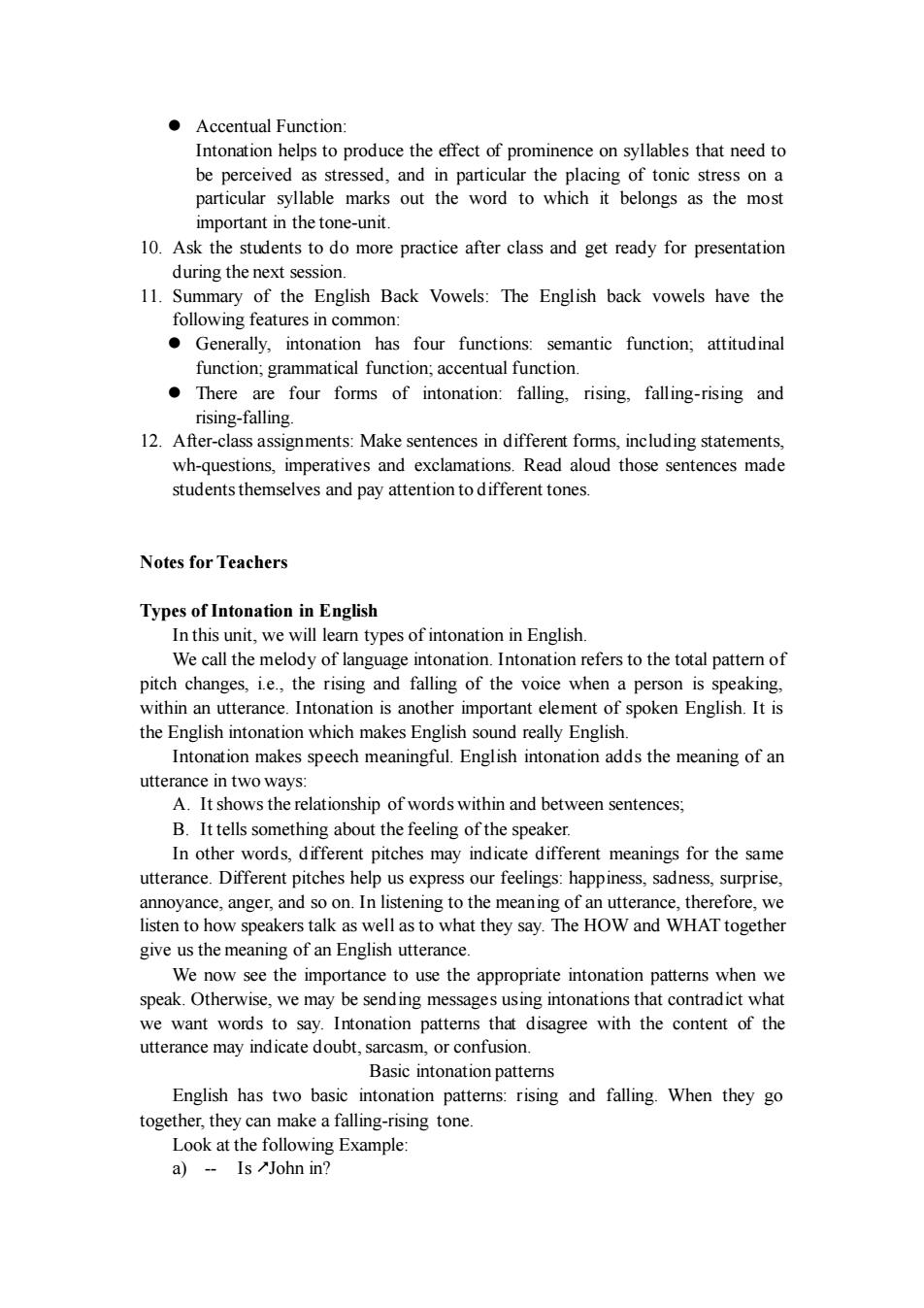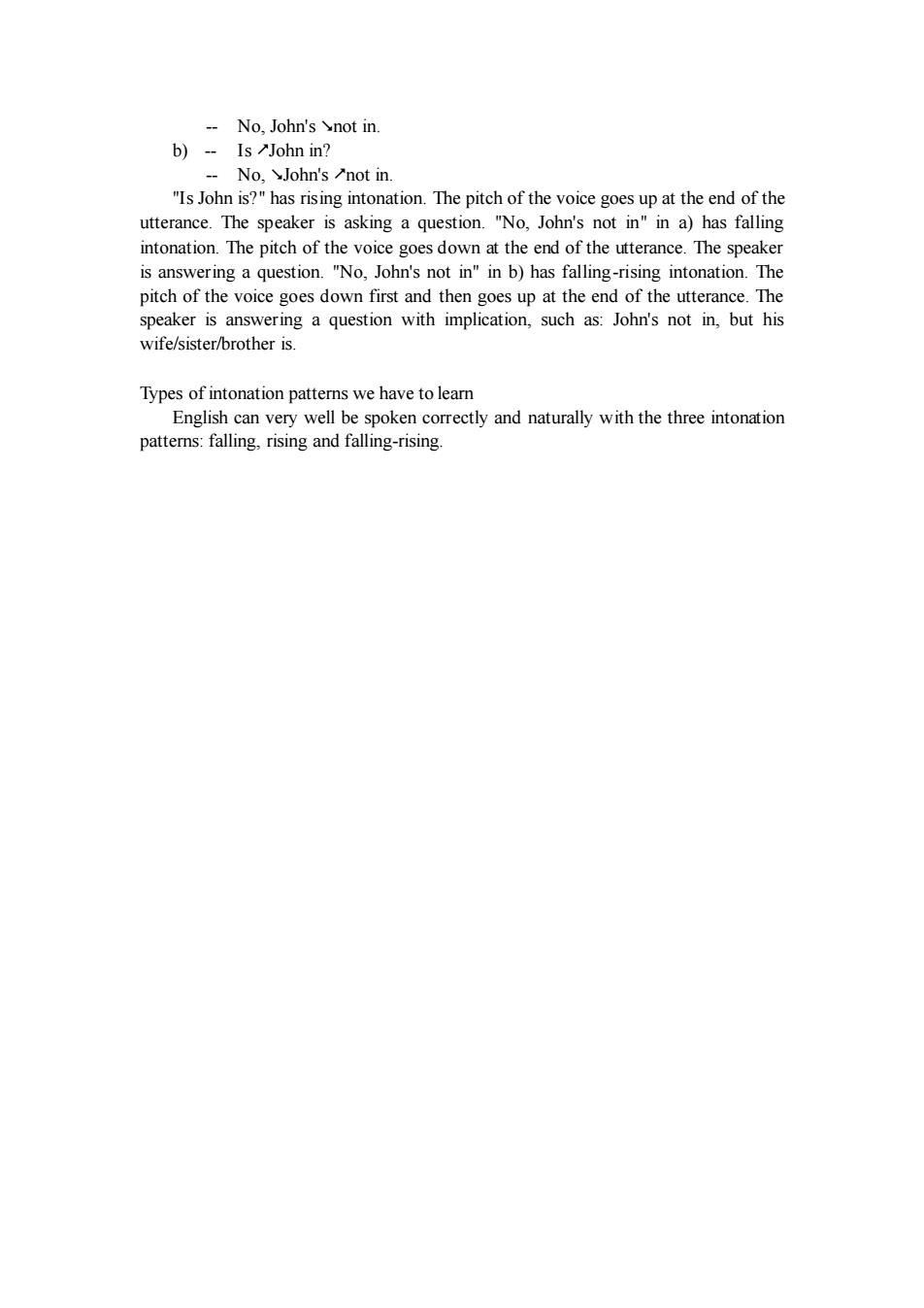
Unit 13 Lesson Plan (With Notes for Teachers) Types of Intonation in English Dates Dec.9.13 Class Cla ses 1,2&3,Grade 2011 Subject: English Pronunciation for Communication Purpose: The students will learn types of intonation in English. Objectives:Students will be able to: Define-in their own words a definition for intonation. 2.Compare-based on the understanding of the basic concept,compare different types of intonation in speech: Practice-imitate the stress patters and intonation and do practice. Resources/Materials: 1.Textbook:Wang,Guizhen,An English Pronunciation Course,Higher Education Press,Beijing,2000; 2.Handouts:illustration of stress patters and rhythmic pattem; Recordings of native speakers Activities and Procedures: 1.Warming-up:Asking the class to read the following phrases in falling tone and rising tone,pay attention to the types of intonation in English. (1)Afriend in need is a friend indeed. (2)There is n smoke withou fire (3)Pass me that book,will you?-Thank you (4)A:Can I help you? B:No,thanks. (5)A:Mr.B. B.Yes? 2.Display examples by playing the recording of the native speakers showing the typical pronunciation in English. 3.Have the students notice the definition of intonation in focus. Intonation:It is often called the melody of language since it refers to the pattem of pitch ch s that he pach ch k.By nge mean the rise and fall of the voice in connected speech.Consisting of different pitch changes. Intonation:It is the musical feature of an utterance.Pitch changes on stressed syllables determine the intonation patterns of an utterance. Intonation:It is actually the combination ofstress and pitch variations
Unit 13 Lesson Plan (With Notes for Teachers) Types of Intonation in English Date: Dec., 9-13 Class: Classes 1, 2 & 3, Grade 2011 Subject: English Pronunciation for Communication Purpose: The students will learn types of intonation in English. Objectives: Students will be able to: 1. Define - in their own words a definition for intonation. 2. Compare – based on the understanding of the basic concept, compare different types of intonation in speech; 3. Practice – imitate the stress patterns and intonation and do practice. Resources/Materials: 1. Textbook: Wang, Guizhen, An English Pronunciation Course, Higher Education Press, Beijing, 2000; 2. Handouts: illustration of stress patterns and rhythmic pattern; 3. Recordings of native speakers Activities and Procedures: 1. Warming-up: Asking the class to read the following phrases in falling tone and rising tone, pay attention to the types of intonation in English. (1) A friend in need is a friend indeed. (2) There is no smoke without fire. (3) Pass me that book, will you? - Thank you. (4) A: Can I help you? B: No, thanks. (5) A: Mr. B. B: Yes? 2. Display examples by playing the recording of the native speakers showing the typical pronunciation in English. 3. Have the students notice the definition of intonation in focus. ⚫ Intonation: It is often called the melody of language since it refers to the pattern of pitch changes that we use when we speak. By pitch changes we mean the rise and fall of the voice in connected speech. Consisting of different pitch changes. ⚫ Intonation: It is the musical feature of an utterance. Pitch changes on stressed syllables determine the intonation patterns of an utterance. ⚫ Intonation: It is actually the combination of stress and pitch variations

4.Have the students to read the following sentence in different tones and point out Pair work A:Mary has married to John. B:Really 5.Have the students listen to the conversations recorded by native speakers of English and try to get the ounds in focu s ct in their 6. Have the stude attention to the intonation Practice A:Well it's certainly cheap And the service. Very good. I particularly like that soup Oh. B:-He died in an accident last night. -What? -I've ta golden watch from my grandfather _Really? 7.Have the students practice the guided conversation.Ask them to pay special attention to the tones of the words underlined while reading.stress. Practice A:Tom broke the window He also translated the announcement I like some cheese.please. What kind of cheese? B:He lives in Beijing. Do you come from Beijing? You com from Bejin My son who studies in Beijing wishes to become a teacher. 8.Comment on the students'performance by highlighting the achievement of the students and the efforts they need for the improvement. 9.Give advice to the students ●Semantic function By the semantic function of intonation we mean that intonation may differentiate the meaning of an utterance Attitudinal Function: The tone we use can tell people a lot about our feeling.our circumstances or surroundings,transcending t ople h ether we are being polite,considerate,concemed o Grammatical Function: Intonation is closely related to grammar or a part of grammar,in much the same way as punctuation is in the written language
4. Have the students to read the following sentence in different tones and point out the differences Pair work : A: Mary has married to John. B: Really. 5. Have the students listen to the conversations recorded by native speakers of English and try to get the sounds in focus correct in their pronunciation. 6. Have the students practice the guided conversation. Ask them to pay special attention to the intonation. Practice: A: Well it’s certainly cheap. And the service. Very good. I particularly like that soup. Oh. B: - He died in an accident last night. - What? - I’ve got a golden watch from my grandfather. - Really? 7. Have the students practice the guided conversation. Ask them to pay special attention to the tones of the words underlined while reading. stress. Practice: A: Tom broke the window. He also translated the announcement. I like some cheese, please. What kind of cheese? B: He lives in Beijing. Do you come from Beijing? You come from Beijing. My son who studies in Beijing wishes to become a teacher. 8. Comment on the students’ performance by highlighting the achievement of the students and the efforts they need for the improvement. 9. Give advice to the students. ⚫ Semantic Function: By the semantic function of intonation we mean that intonation may differentiate the meaning of an utterance. ⚫ Attitudinal Function: The tone we use can tell people a lot about our feeling, our circumstances or surroundings, transcending the words we actually employ; It can indicate our attitude to other people, whether we are being polite, considerate, concerned, sympathetic, indifferent, etc. ⚫ Grammatical Function: Intonation is closely related to grammar or a part of grammar, in much the same way as punctuation is in the written language

Accentual Function: Intonation helps to produce the effect of prominence on syllables that need to be perceived as stressed,and in particular the placing of tonic stress on a particular svllable marks out the word to which it belongs as the most important in the tone-unit. 10.Ask the students to do more practice after class and get ready for presentation during the next sess 11.Summary of the English Back Vowels:The English back vowels have the following features in common: .Generally,intonation has four functions:semantic function;attitudinal function:grammatical function:accentual function. ●There four forms of intonation:falling.rising.falling-rising and rising-falling 12.After-class assignments:Make sentences in different forms,including statements wh-questions,imperatives and exclamations.Read aloud those sentences made students themselves and pay attention to different tones. Notes for Teachers Types of Intonation in English Inthis unit,we will leam types of intonation in English. We call the nelody of la .Intonation refers tothe total pattemof pitch hanges,risingan falling of the voice when a perso s speaking within an utterance.Intonation is another important element of spoken English.It is the English intonation which makes English sound really English. Intonation makes speech meaningful.English intonation adds the meaning of an utterance in two way A.It shows th lationship of words within and between sentences B.It tells something about the feeling of the speaker. In other words,different pitches may indicate different meanings for the same utterance.Different pitches help us express our feelings:happiness,sadness,surprise. e nc anger.and onn senin to the meaning of autterance thereto how kers talk a s well as to what they say.The HOW nd WHAT ethe give us the meaning of an English utterance We now see the importance to use the appropriate intonation patterns when we speak.Otherwise,we may be sending messages using intonations that contradict what we want words to say.Intonation patterns that disagree with the content of the utterance mav indicate doubt.s or confusion Basic intonation pattems English has two basic intonation patterns:rising and falling.When they go together,they can make a falling-rising tone. Look at the following Example: a)-Is/John in?
⚫ Accentual Function: Intonation helps to produce the effect of prominence on syllables that need to be perceived as stressed, and in particular the placing of tonic stress on a particular syllable marks out the word to which it belongs as the most important in the tone-unit. 10. Ask the students to do more practice after class and get ready for presentation during the next session. 11. Summary of the English Back Vowels: The English back vowels have the following features in common: ⚫ Generally, intonation has four functions: semantic function; attitudinal function; grammatical function; accentual function. ⚫ There are four forms of intonation: falling, rising, falling-rising and rising-falling. 12. After-class assignments: Make sentences in different forms, including statements, wh-questions, imperatives and exclamations. Read aloud those sentences made students themselves and pay attention to different tones. Notes for Teachers Types of Intonation in English In this unit, we will learn types of intonation in English. We call the melody of language intonation. Intonation refers to the total pattern of pitch changes, i.e., the rising and falling of the voice when a person is speaking, within an utterance. Intonation is another important element of spoken English. It is the English intonation which makes English sound really English. Intonation makes speech meaningful. English intonation adds the meaning of an utterance in two ways: A. It shows the relationship of words within and between sentences; B. It tells something about the feeling of the speaker. In other words, different pitches may indicate different meanings for the same utterance. Different pitches help us express our feelings: happiness, sadness, surprise, annoyance, anger, and so on. In listening to the meaning of an utterance, therefore, we listen to how speakers talk as well as to what they say. The HOW and WHAT together give us the meaning of an English utterance. We now see the importance to use the appropriate intonation patterns when we speak. Otherwise, we may be sending messages using intonations that contradict what we want words to say. Intonation patterns that disagree with the content of the utterance may indicate doubt, sarcasm, or confusion. Basic intonation patterns English has two basic intonation patterns: rising and falling. When they go together, they can make a falling-rising tone. Look at the following Example: a) - Is John in?

-No,John's vnot in b)-Is/John in? No,John's /not in "Is John is?"has rising intonation.The pitch of the voice goes up at the end of the utterance.The speaker is asking a question."No,John's not in"in a)has falling intonation.The pitch of the voice goes down at the end of the utterance.The speaker question.No.o 's not in"in b)has falling sing intonation.The pitch of the voice goes down first and then goes up at the en the utterance.Th speaker is answering a question with implication,such as:John's not in,but his wife/sister/brother is. Types of intonation pattems we have to leam English ean very well be poke correctly and naturally with the three intonation pattems:falling rising and falling-rising
- No, John's not in. b) - Is John in? - No, John's not in. "Is John is?" has rising intonation. The pitch of the voice goes up at the end of the utterance. The speaker is asking a question. "No, John's not in" in a) has falling intonation. The pitch of the voice goes down at the end of the utterance. The speaker is answering a question. "No, John's not in" in b) has falling-rising intonation. The pitch of the voice goes down first and then goes up at the end of the utterance. The speaker is answering a question with implication, such as: John's not in, but his wife/sister/brother is. Types of intonation patterns we have to learn English can very well be spoken correctly and naturally with the three intonation patterns: falling, rising and falling-rising